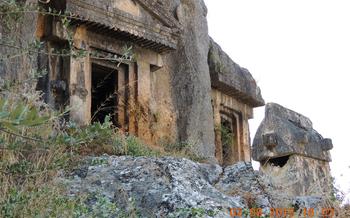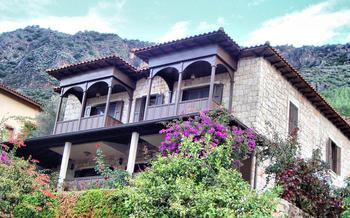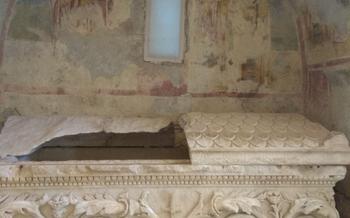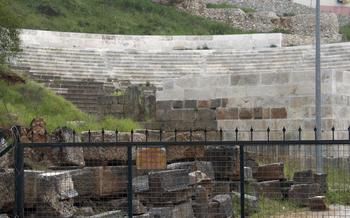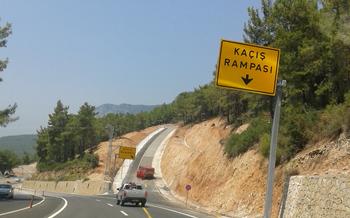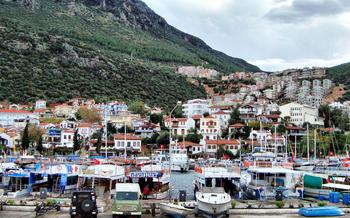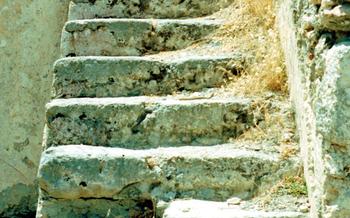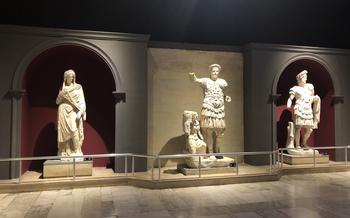
Fethiye Museum of Archaeology
- Fethiye Museum of Archaeology: A Historical Haven
- Journey Through Civilizations
- The Lycian Hall: Unveiling a Lost Civilization
- Mummy Room: A Glimpse into Ancient Funerary Practices
- The Hellenistic and Roman Section: A Legacy of Empires
- Byzantine Treasures: Exploring the Christian Era
- The Ethnographic Section: A Cultural Tapestry
- The Garden of Sculptures: A Walk Through History
- Temporary Exhibitions: A Dynamic Showcase
- Educational Programs: Engaging the Community
- Museum Shop: A Treasure Trove of Souvenirs
- Accessibility and Facilities: Ensuring Inclusivity
- Local Cuisine: A Culinary Adventure
- Insider Tip: Unveiling the Hidden Gem
Fethiye Museum of Archaeology: A Historical Haven
A treasure trove of ancient artifacts and historical wonders, the Fethiye Museum of Archaeology stands as a testament to the rich cultural heritage of Turkey's Ölüdeniz region. Nestled in the heart of Fethiye, this museum invites visitors on a journey through time, showcasing a diverse collection that spans civilizations and epochs.
Founded in 1967, the museum has grown from humble beginnings to become one of the most prominent archaeological museums in Turkey. Its collection, meticulously assembled over decades, offers a glimpse into the lives and cultures of civilizations that once flourished in this region. The museum's location is strategic, positioned within walking distance of other historical sites, making it an ideal starting point for exploring Ölüdeniz's rich past.
The architectural grandeur of the museum itself is a sight to behold. Its imposing façade hints at the treasures within, while the interior layout is designed to maximize accessibility and engagement. The galleries flow seamlessly, leading visitors on a chronological journey through history. Natural light floods the exhibition spaces, illuminating the artifacts and enhancing their allure.
Admission fees are nominal, ensuring accessibility for visitors of all backgrounds. The museum's commitment to inclusivity extends to its multilingual signage and guided tours, catering to a diverse audience. With its comprehensive collection, strategic location, and dedication to preserving history, the Fethiye Museum of Archaeology stands as a must-visit destination for anyone seeking to delve into the cultural tapestry of Turkey.
Journey Through Civilizations
The Fethiye Museum of Archaeology boasts a diverse collection that takes visitors on a journey through the many civilizations that have shaped the region's rich history. From the enigmatic Lycians to the powerful Romans and Byzantines, each era has left its mark on the museum's exhibits.
Notable artifacts include Lycian sarcophagi with intricate carvings depicting scenes from mythology and daily life. Bilingual inscriptions in Lycian and Greek have played a crucial role in deciphering the Lycian language, providing valuable insights into this ancient civilization.
The Hellenistic and Roman section features statues, sculptures, and mosaics that showcase the influence of Greek and Roman culture on the region. Visitors can admire the finely crafted marble statues of gods and goddesses, as well as mosaics depicting scenes from mythology and everyday life.
The Byzantine collection includes artifacts that shed light on the Christian era in Turkey. Icons, frescoes, and architectural elements from churches and monasteries offer a glimpse into the artistic and religious traditions of the Byzantine Empire.
Interactive exhibits and educational displays enhance the museum experience, providing visitors with a deeper understanding of the civilizations represented. These exhibits use multimedia presentations, hands-on activities, and replicas to bring history to life and make it accessible to visitors of all ages.
The Lycian Hall: Unveiling a Lost Civilization
The Lycian Hall of the Fethiye Museum of Archaeology transports visitors to the captivating world of the ancient Lycian civilization. The Lycians, known for their maritime prowess and cultural sophistication, flourished in the region from the 5th century BC to the 2nd century AD.
Peer into the intricate carvings adorning Lycian sarcophagi, each a testament to the artisans' exceptional skill and artistic vision. These elaborate tombs depict scenes from mythology, daily life, and funerary rituals, offering valuable insights into Lycian culture and beliefs.
The Lycian Hall also houses a collection of bilingual inscriptions, etched in both Lycian and Greek. These inscriptions played a crucial role in deciphering the Lycian language, unlocking the secrets of this lost civilization.
Beyond the sarcophagi and inscriptions, the hall showcases a diverse array of artifacts that further illuminate Lycian art and craftsmanship. From delicate jewelry and finely crafted pottery to bronze statuettes and architectural elements, each piece reveals the Lycians' mastery of various artistic techniques.
Immerse yourself in the rich history and cultural legacy of the Lycians as you wander through this captivating hall, gaining a deeper appreciation for this ancient civilization that once thrived on the shores of Turkey.
Mummy Room: A Glimpse into Ancient Funerary Practices
The Fethiye Museum of Archaeology houses a captivating collection of mummies, offering a unique glimpse into ancient Egyptian funerary practices. These mummies, meticulously preserved using various techniques, provide valuable insights into the beliefs and rituals surrounding death and the afterlife in ancient Egypt.
One of the highlights of the collection is a well-preserved mummy of a young woman, dating back to the Ptolemaic period (305-30 BC). The intricately wrapped linen bandages reveal the delicate features of her face, offering a poignant connection to a life that ended centuries ago.
Another notable mummy is that of a priest, adorned with amulets and other funerary objects. The elaborate decorations and inscriptions on his coffin shed light on his religious beliefs and his journey to the afterlife.
The museum also displays a fascinating collection of canopic jars, used by the ancient Egyptians to store the internal organs of the deceased. These jars, often adorned with the heads of the four sons of Horus, offer a glimpse into the complex process of mummification and the significance of preserving the body for the afterlife.
By showcasing these mummies and funerary artifacts, the Fethiye Museum of Archaeology provides visitors with a unique opportunity to explore the ancient Egyptian civilization and its intricate beliefs and rituals surrounding death and the afterlife.
The Hellenistic and Roman Section: A Legacy of Empires
The Hellenistic and Roman periods left an indelible mark on Turkey, and the Fethiye Museum of Archaeology houses a rich collection of artifacts that showcase this legacy. Statues, sculptures, and mosaics depicting Greek and Roman mythology bring to life the stories of gods and heroes, while architectural elements such as columns, capitals, and friezes demonstrate the influence of classical architecture on later periods. The museum also boasts an impressive coin collection, providing insights into the monetary systems and economic activities of these ancient civilizations. Through these artifacts, visitors can trace the evolution of artistic styles, political systems, and cultural traditions that shaped the region during the Hellenistic and Roman eras.
Byzantine Treasures: Exploring the Christian Era
The Fethiye Museum of Archaeology also houses a significant collection of Byzantine artifacts, offering a glimpse into the rich Christian heritage of the region. The Byzantine Empire, which ruled over much of the eastern Mediterranean from the 4th to the 15th century, left an indelible mark on Anatolia, and the museum's Byzantine section showcases this legacy.
Among the highlights of this section are exquisite examples of Byzantine art and iconography. Mosaics, frescoes, and icons depict religious scenes and figures, providing insights into the beliefs and practices of the Byzantine Christians. Architectural remnants of Byzantine churches and monasteries, such as capitals, columns, and lintels, offer a glimpse into the architectural grandeur of this period.
Of particular interest is a collection of well-preserved Byzantine coins, which shed light on the monetary system and economic activities of the empire. These coins often feature images of Byzantine emperors and empresses, along with symbols of Christian iconography, providing valuable historical and numismatic insights.
The Byzantine section of the Fethiye Museum of Archaeology offers a fascinating exploration of the Christian era in Anatolia, showcasing the artistic, cultural, and religious heritage of the Byzantine Empire.
The Ethnographic Section: A Cultural Tapestry
The ethnographic section of the Fethiye Museum of Archaeology offers a captivating journey into the rich cultural heritage of the region. It houses an impressive collection of traditional costumes, textiles, jewelry, and household items, providing a glimpse into the daily lives of various ethnic groups that have called this land home.
The vibrant colors and intricate designs of the traditional costumes are a testament to the region's diverse craftsmanship. Visitors can admire the intricate embroidery, beadwork, and woven patterns that adorn these garments, each telling a story of cultural identity and heritage.
The textiles on display showcase the artistry and skill of local weavers. From delicate lace and intricate tapestries to colorful kilims and rugs, each piece is a unique work of art. The collection includes examples of traditional techniques such as hand-spinning, weaving, and dyeing, offering insights into the region's textile traditions.
Jewelry holds a special place in the ethnographic section. From delicate necklaces and earrings to ornate headdresses and belts, the collection showcases the region's love of adornment. The intricate designs and use of precious metals and gemstones reflect the craftsmanship and cultural influences that have shaped the region's jewelry-making traditions.
Household items and tools provide a glimpse into the domestic life of the region's people. Visitors can explore a variety of objects, including traditional cooking utensils, pottery, agricultural tools, and everyday items such as lamps, furniture, and musical instruments. These artifacts offer a tangible connection to the past and shed light on the ingenuity and resourcefulness of the region's inhabitants.
The ethnographic section of the Fethiye Museum of Archaeology is a celebration of the region's cultural heritage. It invites visitors to embark on a journey of discovery, learning about the traditions, customs, and lifestyles of the diverse communities that have shaped this fascinating region.
The Garden of Sculptures: A Walk Through History
Nestled amidst the tranquil surroundings of the Fethiye Museum of Archaeology lies the Garden of Sculptures, an outdoor oasis that invites visitors to embark on a journey through time. This serene space showcases a diverse collection of sculptures, each narrating a unique story from different eras and artistic movements.
From ancient Greek and Roman masterpieces to contemporary creations, the garden offers a glimpse into the evolution of sculpture. Visitors can admire the intricate details of classical marble statues, marvel at the expressive forms of modern abstract pieces, and appreciate the symbolism embedded in traditional Turkish sculptures.
Thematic arrangements within the garden allow visitors to explore specific periods or styles. One section features a cluster of Hellenistic sculptures, while another showcases Ottoman-era tombstones. Modern and contemporary works are displayed together, creating a dialogue between past and present.
The Garden of Sculptures provides a tranquil setting for contemplation and appreciation of art. Visitors can stroll along the pathways, surrounded by lush greenery and the gentle sound of birdsong. Benches offer moments of respite, inviting visitors to sit and immerse themselves in the beauty of their surroundings.
Whether you are an art enthusiast, a history buff, or simply seeking a peaceful retreat, the Garden of Sculptures at the Fethiye Museum of Archaeology offers a unique and enriching experience.
Temporary Exhibitions: A Dynamic Showcase
The Fethiye Museum of Archaeology, ever striving for innovation and engagement, hosts a dynamic program of temporary exhibitions. These exhibitions, often organized in collaboration with other institutions and international artists, bring a fresh perspective to the museum's offerings. Diverse themes and mediums are explored, showcasing the breadth and richness of archaeological and historical research.
Temporary exhibitions serve as a platform to delve into specific aspects of history, art, and culture. They offer visitors an opportunity to discover new stories and perspectives, challenging their understanding of the past. Through these exhibitions, the museum remains relevant and engaging, attracting a wide range of audiences.
One recent exhibition focused on the ancient Lycian civilization, showcasing newly discovered artifacts that shed light on their unique funerary practices. Another exhibition explored the influence of Hellenistic culture on Roman art, featuring stunning sculptures and mosaics. The museum also hosts regular photography exhibitions, showcasing the work of local and international artists who capture the essence of the region's history and culture.
Temporary exhibitions are a vital part of the Fethiye Museum of Archaeology's mission to educate and inspire visitors. They offer a platform for ongoing exploration, research, and dialogue, ensuring that the museum remains a vibrant and dynamic center for cultural exchange.
Educational Programs: Engaging the Community
The Fethiye Museum of Archaeology is dedicated to educating and engaging the local community through a range of educational programs. These programs are designed to cater to visitors of all ages, from school children to adults, and offer a variety of interactive and immersive learning experiences.
Workshops and lectures are regularly organized, covering a wide range of topics related to archaeology, history, and culture. These events provide an opportunity for visitors to learn from experts in the field and engage in discussions about the latest discoveries and research.
For younger visitors, the museum offers interactive activities and guided tours tailored specifically for children. These programs aim to make learning about history fun and engaging, using hands-on activities, storytelling, and games to bring the past to life.
The museum's educational programs play a crucial role in promoting education and lifelong learning in the community. By fostering a love of history and culture, the museum inspires visitors to become active participants in preserving and protecting their heritage.
Museum Shop: A Treasure Trove of Souvenirs
The Fethiye Museum of Archaeology boasts a well-stocked museum shop that serves as a treasure trove of unique and meaningful souvenirs. Here, visitors can find an array of items to commemorate their visit and take a piece of history home with them.
From meticulously crafted replicas of ancient artifacts to informative books and postcards depicting the region's rich cultural heritage, the museum shop offers a diverse selection of merchandise. Shoppers can browse through intricate replicas of Lycian sarcophagi, delicate jewelry inspired by ancient designs, and beautifully illustrated books showcasing the museum's collection.
By making a purchase at the museum shop, visitors not only acquire a cherished memento but also contribute to the museum's mission of preserving and promoting Turkey's cultural heritage. The revenue generated from sales directly supports the museum's ongoing efforts to maintain its collection, conduct research, and provide educational programs for the community.
Whether seeking a thoughtful gift for a loved one or a unique souvenir to remember their journey, visitors are sure to find something special at the Fethiye Museum of Archaeology's museum shop. So, take the opportunity to browse through its offerings and discover the hidden treasures that await.
Accessibility and Facilities: Ensuring Inclusivity
The Fethiye Museum of Archaeology is committed to providing an inclusive and welcoming environment for all visitors. Accessibility features have been carefully considered to ensure that visitors with disabilities can fully enjoy and engage with the museum's offerings.
Ramps and elevators are strategically placed throughout the museum, allowing wheelchair users to navigate the different levels with ease. Wheelchair-accessible restrooms are also available, providing convenience and comfort for visitors with mobility challenges.
Guided tours and educational programs have been adapted to accommodate visitors with special needs. Trained docents can provide sign language interpretation or use visual aids to enhance understanding for visitors who are deaf or hard of hearing. For visitors with visual impairments, tactile exhibits and audio descriptions are available to help them experience the artifacts and exhibits.
The museum staff is dedicated to assisting visitors with any additional needs or requests. They are always willing to provide guidance, directions, or assistance to ensure that everyone has a positive and enriching experience at the Fethiye Museum of Archaeology.
Local Cuisine: A Culinary Adventure
A visit to the Fethiye Museum of Archaeology is not complete without savoring the delectable local cuisine. Ölüdeniz and its surroundings offer a diverse range of restaurants, from traditional Turkish eateries to modern fusion establishments. Immerse yourself in the flavors of Turkey by trying some must-try dishes.
Start your culinary journey with meze, a selection of small plates that showcase the variety of Turkish cuisine. Indulge in hummus, a creamy dip made from chickpeas, or baba ghanoush, a smoky eggplant puree. Pair these with freshly baked pide, a boat-shaped flatbread topped with various fillings.
For a taste of the sea, order a plate of calamari, tender squid lightly fried and served with a tangy sauce. Sample the sea bass, grilled to perfection and seasoned with aromatic herbs. Vegetarians will delight in zeytinyağlılar, a colorful array of vegetables cooked in olive oil, a staple of Turkish cuisine.
No meal in Ölüdeniz is complete without kebab, succulent grilled meat skewers that are a national favorite. Try the adana kebab, made from minced lamb, or the Urfa kebab, a spicier version with a unique blend of herbs.
For a sweet ending, indulge in künefe, a crispy shredded pastry filled with melted cheese and drizzled with sweet syrup. Turkish delight, a soft and chewy confection flavored with rose water or pistachio, is another must-try dessert.
Remember to support the local economy by dining at family-run restaurants that use fresh, seasonal ingredients. Ask for recommendations from the friendly locals, who will gladly guide you to hidden culinary gems. Embark on a culinary adventure in Ölüdeniz and discover the rich flavors and traditions of Turkish cuisine.
Insider Tip: Unveiling the Hidden Gem
Amidst the many treasures housed within the Fethiye Museum of Archaeology, there lies a hidden gem that often goes unnoticed by visitors rushing through the halls. In the Lycian Hall, nestled among the intricate sarcophagi and bilingual inscriptions, resides a small, unassuming artifact that holds a captivating story. It is a bronze statuette of a Lycian warrior, dating back to the 5th century BC.
This remarkable figurine, standing at a mere 15 centimeters tall, depicts a fierce warrior clad in traditional Lycian armor. His muscular physique, detailed facial features, and intricate helmet adorned with a griffin crest showcase the exceptional craftsmanship of Lycian artisans. The warrior's determined stance and piercing gaze convey a sense of strength and courage, embodying the martial spirit of this ancient civilization.
Despite its small size, this bronze statuette offers a glimpse into the military prowess and cultural identity of the Lycians. It serves as a reminder of the rich history and legacy of this enigmatic people, who once ruled over the lands of Lycia with valor and pride.
To discover this hidden treasure, take your time exploring the Lycian Hall, paying attention to the smaller artifacts that may not immediately catch your eye. As you gaze upon this bronze warrior, let your imagination transport you back in time to the days when Lycian warriors defended their homeland with unwavering bravery.
